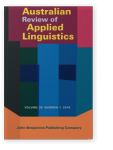The role of L2 learner goal differences in task-generated oral production
In light of the growing interest in the cognitive approach to task in second language (L2) research, comparatively little has been done to examine such effect over time and the role of individual differences (IDs). The present study was designed to verify some longitudinal evidence for the role of tasks in L2 production and whether IDs, in the example of goal orientations, may have a bearing on that role. Thirty lower-intermediate level undergraduates performed narrative tasks during a five-month period and some were subsequently interviewed. Analysis of the data suggests that goal orientation and task conditions have a combined effect on speaking performance and development. In view of that, this paper questions the validity of findings disregarding learner variability and argues for the necessity to direct future research focus at how IDs may interact with tasks in different ways to influence L2 production.
References
Ames, C
(
1992)
Classrooms: Goals, structure and student motivation.
Journal of Educational Psychology, 84(3), 261–271.


Ben Maad, M.R
(
2010)
Holistic and analytic processing modes in non-native learners’ performance of narrative tasks.
System, 38(4), 591–602.


Ben Maad, M.R
(
2012)
Towards a discerning image of learners’ estimation of task difficulty and motivation: Goal orientations highlighted.
Asian EFL Journal, 14(3), 40–61.

Bygate, M
(
2001)
Effects of task repetition on the structure and control of oral language. In:
M. Bygate,
P. Skehan, &
M. Swain (Eds.),
Researching pedagogic tasks: Second language learning, teaching, and testing (pp. 23–48). Harlow: Longman.

Dörnyei, Z
(
2005)
The psychology of language learner: Individual differences in second language acquisition. Mahwah, NJ: Lawrence Erlbaum Associates.

Dörnyei, Z., & Kormos, J
(
2000)
The role of individual and social variables in task performance.
Language Teaching Research, 4(3), 275–300.


Dörnyei, Z., & Skehan, P
(
2003)
Individual differences in second language learning. In:
C. Doughty &
M.H. Long (Eds.),
The handbook of second language acquisition (pp. 589–63). Oxford: Blackwell.


Ellis, R
(
2000)
Task-based research and language pedagogy.
Language Teaching Research, 4(3), 193–220.


Ellis, R
(
2003)
Task-based language learning and teaching. Oxford: Oxford University Press.

Ellis, R
(
2009)
The differential effects of three types of task planning on the fluency, complexity, and accuracy in L2 oral production.
Applied Linguistics, 30(4), 474–509.


Ellis, R., & Barkhuizen, B
(
2005)
Analysing learner language. Oxford: Oxford University Press.

Foster, P., &Skehan, P
(
1996)
The influence of planning on performance in task-based learning.
Studies in Second Language Acquisition, 18(3), 299–324.


Foster, P., Tonkyn, A., & Wigglesworth, G
(
2000)
Measuring spoken language: A unit for all reasons.
Applied Linguistics, 21(3), 354–375.


Gass, S., Mackey, A., Alvarez-Torres, M.J., & Fernandez-Garcia, M
(
1999)
The effects of task repetition on linguistic output.
Language Learning, 491, 549–581.


He, T
(
2005)
Effects of mastery and performance goals on the composition strategy use of adult EFL writers.
The Canadian Modern Language Review, 61(4), 407–431.


Housen, A., Kuiken, F., & Vedder, I
Iwashita, N., McNamara, T., & Elder, C
(
2001)
Can we predict task difficulty in an oral proficiency test? Exploring the potential of an information processes approach to task design.
Language Learning, 21(3), 401–436.


Kim, Y., & Tracy-Ventura, N
(
2013)
The role of task repetition in L2 performance development: What needs to be repeated during task-based interaction? System, 41(3), 829–840.


Kormos, J
(
1999)
Monitoring and self-repair in L2.
Language Learning, 49(2), 303–342.


Kormos, J
(
2006)
Speech production and second language acquisition. Mahwah: Lawrence Erlbaum.

Kuiken, F., Mos, M., & Vedder, I
(
2005)
Cognitive task complexity and second language writing performance. In:
S. Foster-Cohen &
P. García-Mayo (Eds.),
Eurosla Yearbook (pp. 195–222). Amsterdam: John Benjamins.

Larsen-Freeman, D
(
2006)
The emergence of complexity, fluency, and accuracy in the oral and written production of five Chinese learners of English.
Applied Linguistics, 27(4), 590–619.


Levkina, M., & Gilabert, Y
Mackey, A., & Gass, S
(
2005)
Second language research methodology and design. Mahwah: Lawrence Erlbaum.

McLaughlin, B
(
1990)
Restructuring.
Applied Linguistics, 11(2), 113–128.


Ortega, L
(
1999)
Planning and focus on form in L2 oral performance.
Studies in Second Language Acquisition, 21(1), 109–148.


Raupach, M
(
1984)
Formulae in second language speech production. In:
H. Dechert,
D. Möhle, &
M. Raupach (Eds.),
Second language productions (pp. 114–137). Tübignen: Gunter Narr Verlag.

Révész, A
(
2014)
Towards a fuller assessment of cognitive models of task-based learning: Investigating task-generated cognitive demands and processes.
Applied Linguistics, 35(1), 87–92.


Robinson, P
(
2001)
Task complexity, cognitive resources, and syllabus design: A triadic framework for examining task influences on SLA. In:
P. Robinson (Ed.),
Cognition and second language instruction (pp. 114–137). Cambridge: Cambridge University Press.


Sangarun, J
(
2001)
The effects of pre-task planning on foreign language performance (Unpublished doctoral thesis), OISE-University of Toronto.

Skehan, P
(
1998)
A cognitive approach to language learning. Oxford: Oxford University Press.

Skaalvik, E
(
1997)
Self-enhancing and self-defeating ego orientation: Relations with task and avoidance orientation, achievement, self-perceptions, and anxiety.
Journal of Educational Psychology, 89(1), 71–81.


Steele-Johnson, D., Beauregard, R., Hoover, P., & Schmidt, A
(
2000)
Goal orientation and task complexity effects on motivation, affect, and performance.
Journal of Applied Psychology, 85(5), 724–738.


Tavakoli, P., & Skehan, P
Towell, R., Hawkins, R., & Bazergui, N
(
1996)
The development of fluency in advanced learners of French.
Applied Linguistics, 17(1), 84–119.


Wolfe-Quintero, K., Inagaki, S., & Kim, H.Y
(
1998)
Second language development in writing: Measures of fluency, accuracy and complexity. Technical report 17. Manoa: University of Hawai’i Press.

Cited by
Cited by 3 other publications
Ben Maad, Mohamed Ridha & Ibrahim Saadi
2020.
The role of group dynamics in low‐achieving EFL students’ speaking development.
International Journal of Applied Linguistics 30:2
► pp. 264 ff.

Mister, Bianca, Honglin Chen & Amanda Baker
This list is based on CrossRef data as of 29 june 2024. Please note that it may not be complete. Sources presented here have been supplied by the respective publishers.
Any errors therein should be reported to them.
